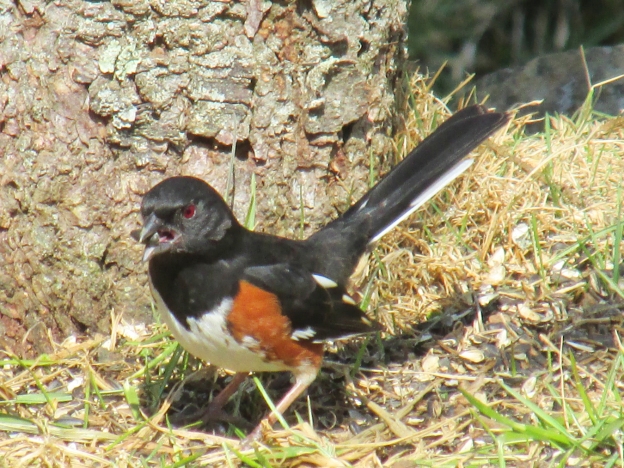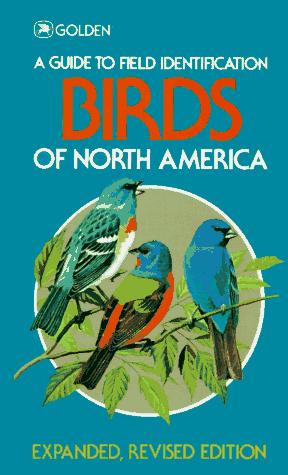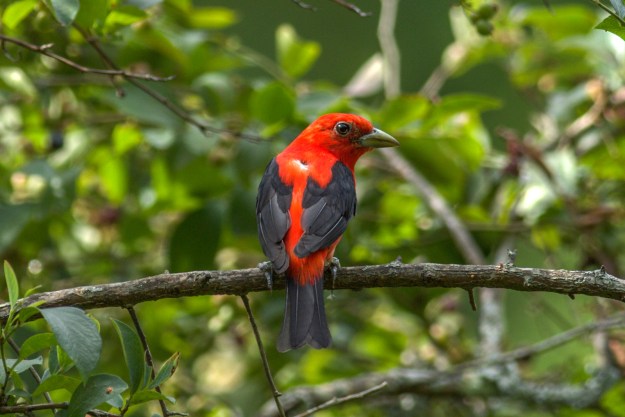Summer heat and humidity make the summer season my least favorite one for birding, but every season brings birding surprises. I was reminded of this fact when Larry and Amelia Tipton sent me a recent email asking for help with the identification of some birds near their home.
Attaching a photo with their email, the Tiptons wrote, “These birds showed up a few days ago and we cannot identify them. We would like to know what they are.”
When I opened the photo, I realized that the birds captured in the image would not be considered out of place if the Tiptons lived near the coast of the Carolinas, Georgia or Florida. The birds in the photo, however, were somewhat unexpected in the foothills of western North Carolina near their home in the town of Old Fort.

Photo Courtesy of Larry and Amelia Tipton • Immature white ibises in a field near the Catawba River in North Carolina.
“We live on a farm near the Catawba River but have mostly woodland and fields,” the couple added. “We do not have a pond on our property but have a branch and a larger creek nearby.”
I wrote back and told the Tiptons that the birds they photographed were young white ibises. I informed the Tiptons that the two young ibises are likely testing their wings, so to speak, after leaving the care of their parents. If they like the area, and it sounds like they do, they may decide that the branch and creek are just what they need.
I received a followup email. “We sort of knew these were water birds but were surprised to find them so far away from marsh or wetlands or the ocean,” the Tiptons wrote. “We thought maybe a storm blew them off course during flight.”
While a diverting storm can’t be ruled out, it’s normal behavior for young wading birds to disperse far and wide after leaving the nest. North American waders, or wading birds, include such long-legged species as herons, egrets, bitterns, ibises, storks and spoonbills. Most species are associated with wetlands or coastal areas.
Late summer birding is usually a period of doldrums as heat and humidity can discourage birders as well as diminish bird activity. However, it’s also the time of year when birders can make some unexpected surprises as wandering waders, such as the ibises discovered by the Tiptons, explore uncharted territory.
Other waders this season showing up in unexpected location have included a wood stork found by Linda Walker in Polk County, Tennessee. Likes the ibises in North Carolina, the stork was confining its activities to a small branch bordered by heavy vegetation. These branches are a far cry from the usual wetland haunts of these two species.
Overall, the white ibis and wood stork have some superficial similarities. They are both long-legged white birds with black wing tips and unusual down-turned bills that they use to probe for food, which largely consists of fish and other aquatic prey.
The latter is North America’s only native stork. According to the National Audubon Society, Florida once provided a stronghold for the wood stork in the United States. Unfortunately, the population crashed in the 1990s, decreasing from around 150,000 birds to fewer than 10,000. In recent years, numbers have increased and wood storks have expanded their breeding range into South Carolina. Wood storks are nearly four feet tall, making them one of the tallest of the waders. Wood storks have a dark, featherless heads, giving them a resemblance to vultures. For the most part, they’re rather grotesque birds when observed at close quarters. Soaring overhead on thermal updrafts, wood storks look quite graceful and even majestic thanks to their white plumage and black accents. A wingspan of 65 inches gives them the means to soar easily.

Photo by Bryan Stevens
Worldwide there are 19 species of storks, but the wood stork (pictured) is the only native stork found in the United States.
The Audubon Society identifies the white ibis as one of the most numerous wading birds in Florida, but the bird is common also in other parts of the southeast with appropriate wetland habitat. Like the wood stork, the ibis has declined in Florida in recent decades largely as a result of human encroachment. The white ibis looks like a bird that could have been invented by Dr. Seuss. The all-white plumage is contrasted by pinkish-orange legs, a reddish-pink bill and bright blue eyes. In flight, the white ibis shows black feathers on the edges of its wings.
The affinity for water and wetlands relates to the diet of most waders, which consists of fish and other aquatic prey such as amphibians, crustaceans and even insects. For the remainder of July and into August and September, birders should monitor ponds, small lakes, rivers and even branches and creeks for any wandering waders. For instance, I once made a trip to a park in Greeneville, Tennessee, to observe a pink-hued roseate spoonbill that had made a rare stopover in the region. While that observation took place nearly 20 years ago, I remember vividly finding the pale pink bird playing odd man out among a flock of several dozen Canada geese as a soft rain drizzled from an overcast sky. Although many of the waders cling to coastal habitats, they have wings like other birds and know how to use them. Other waders have been known to show up in unlikely locations, including birds such as tri-colored heron, limpkin and snowy egret.
Of course, I hope to hear from any readers lucky enough to glimpse one of these unanticipated finds. Enjoy your birding.
•••••
Bryan Stevens lives near Roan Mountain, Tennessee. To learn more about birds and other topics from the natural world, friend Stevens on Facebook at https://www.facebook.com/ahoodedwarbler. He is always posting about local birds, wildlife, flowers, insects and much more.





























